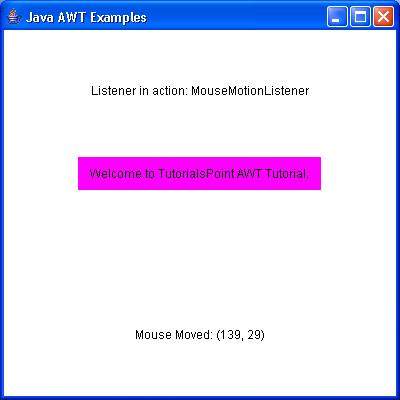
- AWT Tutorial
- AWT - Home
- AWT - Overview
- AWT - Environment
- AWT - Controls
- AWT - Event Handling
- AWT - Event Classes
- AWT - Event Listeners
- AWT - Event Adapters
- AWT - Layouts
- AWT - Containers
- AWT - Menu
- AWT - Graphics
- AWT Useful Resources
- AWT - Quick Guide
- AWT - Useful Resources
- AWT - discussion
AWT MouseMotionListener Interface
Introduction
The interfaceMouseMotionListener is used for receiving mouse motion events on a component. The class that process mouse motion events needs to implements this interface.
Class declaration
Following is the declaration for java.awt.event.MouseMotionListener interface:
public interface MouseMotionListener extends EventListener
Interface methods
| S.N. | Method & Description |
|---|---|
| 1 | void mouseDragged(MouseEvent e) Invoked when a mouse button is pressed on a component and then dragged. |
| 2 | void mouseMoved(MouseEvent e) Invoked when the mouse cursor has been moved onto a component but no buttons have been pushed. |
Methods inherited
This class inherits methods from the following interfaces:
java.awt.event.EventListener
MouseMotionListener Example
Create the following java program using any editor of your choice in say D:/ > AWT > com > tutorialspoint > gui >
AwtListenerDemo.java
package com.tutorialspoint.gui;
import java.awt.*;
import java.awt.event.*;
public class AwtListenerDemo {
private Frame mainFrame;
private Label headerLabel;
private Label statusLabel;
private Panel controlPanel;
public AwtListenerDemo(){
prepareGUI();
}
public static void main(String[] args){
AwtListenerDemo awtListenerDemo = new AwtListenerDemo();
awtListenerDemo.showMouseMotionListenerDemo();
}
private void prepareGUI(){
mainFrame = new Frame("Java AWT Examples");
mainFrame.setSize(400,400);
mainFrame.setLayout(new GridLayout(3, 1));
mainFrame.addWindowListener(new WindowAdapter() {
public void windowClosing(WindowEvent windowEvent){
System.exit(0);
}
});
headerLabel = new Label();
headerLabel.setAlignment(Label.CENTER);
statusLabel = new Label();
statusLabel.setAlignment(Label.CENTER);
statusLabel.setSize(350,100);
controlPanel = new Panel();
controlPanel.setLayout(new FlowLayout());
mainFrame.add(headerLabel);
mainFrame.add(controlPanel);
mainFrame.add(statusLabel);
mainFrame.setVisible(true);
}
private void showMouseMotionListenerDemo(){
headerLabel.setText("Listener in action: MouseMotionListener");
Panel panel = new Panel();
panel.setBackground(Color.magenta);
panel.setLayout(new FlowLayout());
panel.addMouseMotionListener(new CustomMouseMotionListener());
Label msglabel = new Label();
msglabel.setAlignment(Label.CENTER);
msglabel.setText("Welcome to TutorialsPoint AWT Tutorial.");
panel.add(msglabel);
controlPanel.add(panel);
mainFrame.setVisible(true);
}
class CustomMouseMotionListener implements MouseMotionListener {
public void mouseDragged(MouseEvent e) {
statusLabel.setText("Mouse Dragged: ("+e.getX()+", "+e.getY() +")");
}
public void mouseMoved(MouseEvent e) {
statusLabel.setText("Mouse Moved: ("+e.getX()+", "+e.getY() +")");
}
}
}
Compile the program using command prompt. Go to D:/ > AWT and type the following command.
D:\AWT>javac com\tutorialspoint\gui\AwtListenerDemo.java
If no error comes that means compilation is successful. Run the program using following command.
D:\AWT>java com.tutorialspoint.gui.AwtListenerDemo
Verify the following output
